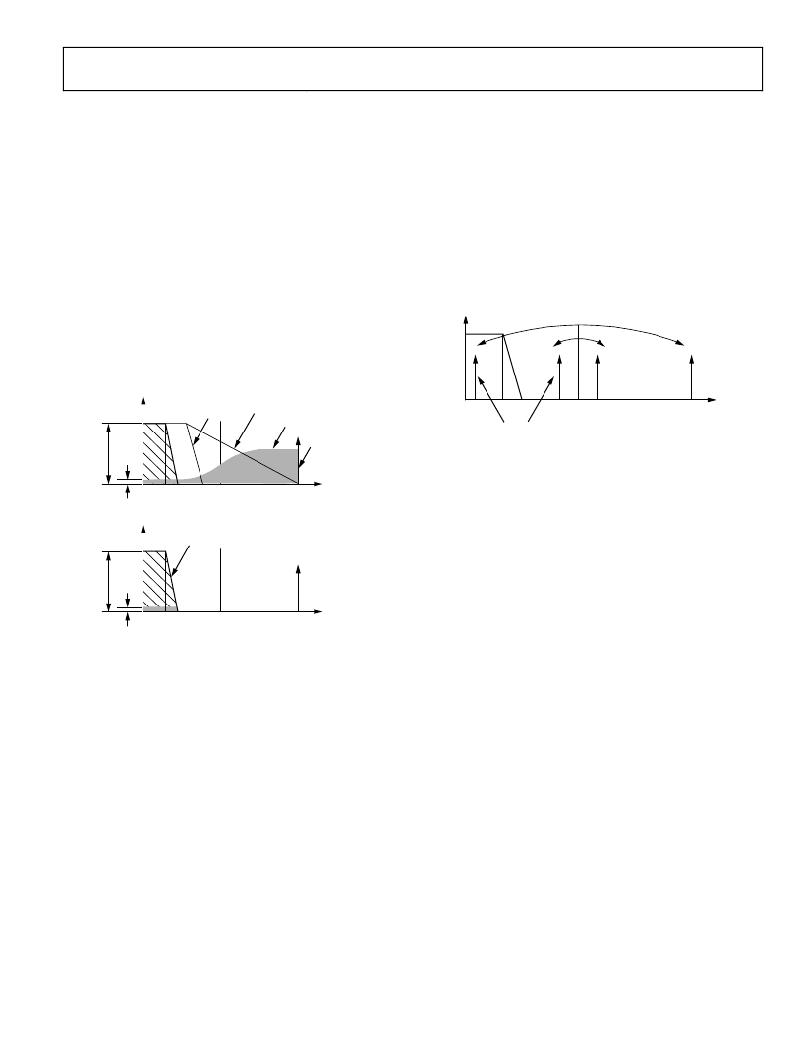- 您现在的位置:买卖IC网 > Sheet目录1214 > EVAL-ADE7878EBZ (Analog Devices Inc)BOARD EVAL FOR ADE7878
�� �
�
 �
�Data� Sheet�
�the� bandwidth� of� interest.� For� example,� the� sampling� rate� in�
�the� ADE7854� /� ADE7858� /� ADE7868� /� ADE7878� is� 1.024� MHz,�
�and� the� bandwidth� of� interest� is� 40� Hz� to� 2� kHz.� Oversampling�
�has� the� effect� of� spreading� the� quantization� noise� (noise� due� to�
�sampling)� over� a� wider� bandwidth.� With� the� noise� spread� more�
�thinly� over� a� wider� bandwidth,� the� quantization� noise� in� the� band�
�of� interest� is� lowered,� as� shown� in� Figure� 31.� However,� oversam-�
�pling� alone� is� not� efficient� enough� to� improve� the� signal-to-noise�
�ratio� (SNR)� in� the� band� of� interest.� For� example,� an� oversampling�
�factor� of� 4� is� required� just� to� increase� the� SNR� by� a� mere� 6� dB�
�(1� bit).� To� keep� the� oversampling� ratio� at� a� reasonable� level,� it� is�
�possible� to� shape� the� quantization� noise� so� that� the� majority� of�
�the� noise� lies� at� the� higher� frequencies.� In� the� Σ-Δ� modulator,�
�ADE7854/ADE7858/ADE7868/ADE7878�
�and� prevent� the� distortion� of� the� band� of� interest,� a� low-pass�
�filer� (LPF)� must� be� introduced.� For� conventional� current�
�sensors,� it� is� recommended� to� use� one� RC� filter� with� a� corner�
�frequency� of� 5� kHz� for� the� attenuation� to� be� sufficiently� high� at�
�the� sampling� frequency� of� 1.024� MHz.� The� 20� dB� per� decade�
�attenuation� of� this� filter� is� usually� sufficient� to� eliminate� the�
�effects� of� aliasing� for� conventional� current� sensors.� However,� for� a�
�di/dt� sensor� such� as� a� Rogowski� coil,� the� sensor� has� a� 20� dB� per�
�decade� gain.� This� neutralizes� the� 20� dB� per� decade� attenuation�
�produced� by� the� LPF.� Therefore,� when� using� a� di/dt� sensor,� take�
�care� to� offset� the� 20� dB� per� decade� gain.� One� simple� approach� is�
�to� cascade� one� additional� RC� filter,� thereby� producing� a� ?40� dB�
�per� decade� attenuation.�
�the� noise� is� shaped� by� the� integrator,� which� has� a� high-pass-type�
�response� for� the� quantization� noise.� This� is� the� second� technique�
�used� to� achieve� high� resolution.� The� result� is� that� most� of� the�
�noise� is� at� the� higher� frequencies� where� it� can� be� removed� by�
��ANTIALIAS� FILTER�
�ALIASING� EFFECTS�
�SAMPLING�
�FREQUENCY�
�SIGNAL�
�NOISE�
�DIGITAL� FILTER�
�(RC)�
�SHAPED� NOISE�
�SAMPLING�
�FREQUENCY�
�0� 2� 4� 512�
�FREQUENCY� (kHz)�
�IMAGE�
�FREQUENCIES�
�Figure� 32.� Aliasing� Effects�
�ADC� Transfer� Function�
�1024�
�0�
�2�
�4�
�512�
�FREQUENCY� (kHz)�
�1024�
�All� ADCs� in� the� ADE7854� /� ADE7858� /� ADE7868� /� ADE7878� are�
�designed� to� produce� the� same� 24-bit� signed� output� code� for� the�
�SIGNAL�
�NOISE�
�HIGH� RESOLUTION�
�OUTPUT� FROM�
�DIGITAL� LPF�
�same� input� signal� level.� With� a� full-scale� input� signal� of� 0.5� V�
�and� an� internal� reference� of� 1.2� V,� the� ADC� output� code� is� nomi-�
�nally� 5,928,256� (0x5A7540).� The� code� from� the� ADC� can� vary�
�between� 0x800000� (?8,388,608)� and� 0x7FFFFF� (+8,388,607);�
�this� is� equivalent� to� an� input� signal� level� of� ±0.707� V.� However,�
�for� specified� performance,� do� not� exceed� the� nominal� range� of�
�0� 2� 4� 512� 1024�
�FREQUENCY� (kHz)�
�Figure� 31.� Noise� Reduction� Due� to� Oversampling� and�
�Noise� Shaping� in� the� Analog� Modulator�
�Antialiasing� Filter�
����is� an� artifact� of� all� sampled� systems� as� shown� in� Figure� 32.� Aliasing�
�means� that� frequency� components� in� the� input� signal� to� the�
�ADC,� which� are� higher� than� half� the� sampling� rate� of� the� ADC,�
�appear� in� the� sampled� signal� at� a� frequency� below� half� the�
�sampling� rate.� Frequency� components� above� half� the� sampling�
�frequency� (also� known� as� the� Nyquist� frequency,� that� is,� 512� kHz)�
�are� imaged� or� folded� back� down� below� 512� kHz.� This� happens�
�with� all� ADCs� regardless� of� the� architecture.� In� the� example� shown,�
�only� frequencies� near� the� sampling� frequency,� that� is,� 1.024� MHz,�
�move� into� the� band� of� interest� for� metering,� that� is,� 40� Hz� to�
�±0.5� V;� ADC� performance� is� guaranteed� only� for� input� signals�
�lower� than� ±0.5� V.�
�CURRENT� CHANNEL� ADC�
��Input� IA� of� the� current� channels� (it� is� the� same� for� IB� and� IC).�
�The� ADC� outputs� are� signed� twos� complement� 24-bit� data-�
�words� and� are� available� at� a� rate� of� 8� kSPS� (thousand� samples�
�per� second).� With� the� specified� full-scale� analog� input� signal�
�of� ±0.5� V,� the� ADC� produces� its� maximum� output� code� value.�
��ential� inputs� (IAP� and� IAN).� The� ADC� output� swings� between�
�?5,928,256� (0xA58AC0)� and� +5,928,256� (0x5A7540).� The�
�input,� IN,� corresponds� to� the� neutral� current� of� a� 3-phase�
�system� (available� in� the� ADE7868� and� ADE7878� only).� If� no�
�neutral� line� is� present,� connect� this� input� to� AGND.� The�
�datapath� of� the� neutral� current� is� similar� to� the� path� of� the�
��2� kHz.� To� attenuate� the� high� frequency� (near� 1.024� MHz)� noise�
�Rev.� H� |� Page� 29� of� 100�
�发布紧急采购,3分钟左右您将得到回复。
相关PDF资料
EVAL-ADE7880EBZ
BOARD EVAL FOR ADE7880
EVAL-ADE7953EBZ
BOARD EVAL FOR ADE7953
EVAL-ADF4002EBZ1
BOARD EVAL FOR ADF4002
EVAL-ADG788EBZ
BOARD EVALUATION FOR ADG788
EVAL-ADM1021AEB
BOARD EVAL FOR ADM1021
EVAL-ADM1023EB
BOARD EVAL FOR ADM1023
EVAL-ADM1031EB
BOARD EVAL FOR ADM1031
EVAL-ADM1062TQEBZ
BOARD EVALUATION FOR ADM1062TQ
相关代理商/技术参数
EVAL-ADE7880EBZ
功能描述:BOARD EVAL FOR ADE7880 RoHS:是 类别:编程器,开发系统 >> 评估演示板和套件 系列:* 产品培训模块:Obsolescence Mitigation Program 标准包装:1 系列:- 主要目的:电源管理,电池充电器 嵌入式:否 已用 IC / 零件:MAX8903A 主要属性:1 芯锂离子电池 次要属性:状态 LED 已供物品:板
EVAL-ADE7880EBZ
制造商:Analog Devices 功能描述:ADE7880, ENERGY METER, 3 PH, SPI, I2C, E
EVAL-ADE7913EBZ
制造商:AD 制造商全称:Analog Devices 功能描述:3-Channel, Isolated, Sigma-Delta ADC with SPI
EVAL-ADE7953EBZ
功能描述:BOARD EVAL FOR ADE7953 RoHS:是 类别:编程器,开发系统 >> 评估演示板和套件 系列:- 标准包装:1 系列:PSoC® 主要目的:电源管理,热管理 嵌入式:- 已用 IC / 零件:- 主要属性:- 次要属性:- 已供物品:板,CD,电源
EVAL-ADF4001EBZ2
制造商:Analog Devices 功能描述:Evaluation Board For Pll Frequency Synthesizer 制造商:Analog Devices 功能描述:ADF4001 PLL SYNTHESIZER EVAL BOARD
EVAL-ADF4002EB1
制造商:Analog Devices 功能描述:EVAL BOARD - Bulk
EVAL-ADF4002EBZ1
功能描述:BOARD EVAL FOR ADF4002 RoHS:是 类别:编程器,开发系统 >> 评估演示板和套件 系列:- 产品培训模块:Obsolescence Mitigation Program 标准包装:1 系列:- 主要目的:电源管理,电池充电器 嵌入式:否 已用 IC / 零件:MAX8903A 主要属性:1 芯锂离子电池 次要属性:状态 LED 已供物品:板
EVAL-ADF4007EBZ1
功能描述:BOARD EVALUATION FOR ADF4007EB1 RoHS:是 类别:编程器,开发系统 >> 评估演示板和套件 系列:- 标准包装:1 系列:PSoC® 主要目的:电源管理,热管理 嵌入式:- 已用 IC / 零件:- 主要属性:- 次要属性:- 已供物品:板,CD,电源